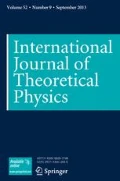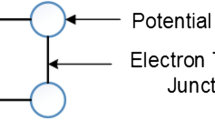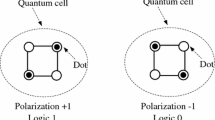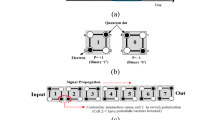Abstract
Quantum-dot Cellular Automata (QCA) is an emerging nanotechnology and a possible alternative to overcome the limitations of complementary metal oxide semiconductor (CMOS) technology. One of the most attractive fields in QCA is the implementation of digital system. As, information loss is a major issue in irreversible digital computation systems. Therefore, reduced heat dissipation is an increasing demand for nano-scale computations. Reversible logic designs are good competitor towards sustainable digital systems. This paper presents two new reversible logic gates viz., 3 × 3-New Reversible Gate (3 × 3-NRG), and Modified Feynman Gate (MFG). The proposed gates are tested by designing an optimal reversible single layer full adder-subtractor circuit (RFAS). Based on the simulation results, it is observed that the proposed RFAS is an efficient arithmetic logic circuit and has reduced area, less circuit complexity and less number of clock delays over existing designs. In addition, a complete propagation path flow of the RFAS is also presented. Meanwhile, the energy dissipation analysis of the proposed RFAS is verified using three separate energy levels (γ = 0.5Ek, γ = 1.0, Ek and γ = 1.5Ek), at T = 2 K in QCAPro tool. It is observed that the proposed RFAS design dissipates less energy compared to the traditional approaches.










Similar content being viewed by others
References
Lent, C.S., Tougaw, P.D., Porod, W., Bernstein, G.H.: Quantum cellular automata. Nanotechnology 4, 49 (1993)
Smith, C.G.: Computation without current. Science 284, 274–274 (1999)
Bilal, B., Ahmed, S., Kakkar, V.: Modular adder designs using optimal reversible and fault tolerant gates in field-coupled QCA nanocomputing. Int. J. Theor. Phys. 57(5), 1356–1375 (2018)
Bilal, B., Ahmed, S., Kakkar, V.: An insight into beyond CMOS Next generation computing using quantum-dot cellular automata nanotechnology. Int. J. Eng. Manuf. 8(1), 25–37 (2018)
Tougaw, P.D., Lent, C.S.: Logical devices implemented using quantum cellular automata. J. Appl. Phys. 75, 1818–1825 (1994)
Frost, S.E., Rodrigues, A.F., Janiszewski, A.W., Rausch, R.T., Kogge, P.M.: Memory in Motion: a Study of Storage Structures in QCA. In: First Workshop on Non-Silicon Computing (2002)
Niemier, M.T., Kogge, P.M.: Logic in wire: using quantum dots to implement a microprocessor. In: The 6th IEEE International Conference on Electronics, Circuits and Systems, 1999. Proceedings of ICECS’99, pp. 1211–1215 (1999)
Amlani, I., Orlov, A.O., Toth, G., Bernstein, G.H., Lent, C.S., Snider, G.L.: Digital logic gate using quantum-dot cellular automata. Science 284, 289–291 (1999)
Bilal, B., Ahmed, S., Kakkar, V.: Quantum dot cellular automata: a new paradigm for digital design. Int. J. Nanoelectron. Mater. 11(1), 87–98 (2018)
Landauer, R.: Irreversibility and heat generation in the computing process. IBM J. Res. Dev. 5, 183–191 (1961)
Bennett, C.H.: Logical reversibility of computation. IBM J. Res. Dev. 17, 525–532 (1973)
Bilal, B., Ahmed, S., Kakkar, V.: QCA based efficient Toffoli gate design and implementation for nanotechnology applications. Int. J. Eng. Technol. 9, 84–92 (2017)
Bilal, B., Ahmed, S., Kakkar, V.: Optimal realization of Universality of Peres gate using explicit interaction of cells in quantum dot cellular automata nanotechnology. Int. J. Intell. Syst. Appl. 9, 75 (2017)
Ahmad, F.: An optimal design of QCA based 2n: 1/1: 2n multiplexer/demultiplexer and its efficient digital logic realization. Microprocess. Microsyst. 56, 64–75 (2018)
Sen, B., Dutta, M., Goswami, M., Sikdar, B.K.: Modular design of testable reversible ALU by QCA multiplexer with increase in programmability. Microelectron. J. 45, 1522–1532 (2014)
Sen, B., Dutta, M., Some, S., Sikdar, B.K.: Realizing reversible computing in QCA framework resulting in efficient design of testable ALU. ACM J. Emerg. Technol. Comput. Syst. (JETC) 11, 30 (2014)
Ma, X., Huang, J., Metra, C., Lombardi, F.: Reversible and testable circuits for molecular QCA design. In: Emerging Nanotechnologies, ed, pp. 157–202. Springer (2008)
Mohammadi, Z., Mohammadi, M.: Implementing a one-bit reversible full adder using quantum-dot cellular automata. Quantum Inf. Process. 13, 2127–2147 (2014)
Taherkhani, E., Moaiyeri, M.H., Angizi, S.: Design of an ultra-efficient reversible full adder-subtractor in quantum-dot cellular automata. Optik-Int. J. Light Electron. Opt. 142, 557–563 (2017)
Biswas, P.K., Bahar, A.N., Habib, M.A., Nahid, N.M., Bhuiyan, M.M.R.: An efficient design of reversible subtractor in quantum-dot cellular automata. Int. J. Grid Distributed Comput. 10, 13–23 (2017)
Thapliyal, H., Ranganathan, N.: Reversible logic-based concurrently testable latches for molecular QCA. IEEE Trans. Nanotechnol. 9, 62–69 (2010)
Sen, B., Saran, D., Saha, M., Sikdar, B.K.: Synthesis of reversible universal logic around QCA with online testability. In: 2011 International Symposium on Electronic System Design (ISED), pp. 236–241 (2011)
Kanth, B.R., Krishna, B.M., Sridhar, M., Swaroop, V.S.: A distinguish between reversible and conventional logic gates. Int. J. Eng. Res. Appl. 2(2), 148–151 (2012)
Lombardi, F., Huang, J.: Design and Test of Digital Circuits by Quantum-Dot Cellular Automata. Artech House, Norwood (2007)
Timler, J., Lent, C.S.: Power gain and dissipation in quantum-dot cellular automata. J. Appl. Phys. 91, 823–831 (2002)
Ghosh, S., Kaushik, R.: Exploring high-speed low-power hybrid arithmetic units at scaled supply and adaptive clock-stretching. In: Asia and South Pacific Design Automation Conference, 2008. ASPDAC 2008, pp. 635–640 (2008)
Akter, R., Islam, N., Waheed, S.: Implementation of reversible logic gate in quantum dot cellular automata. Int. J. Comput. Appl. 109(1), 41–44 (2015)
Ahmad, F., Bhat, G.M., Khademolhosseini, H., Azimi, S., Angizi, S., Navi, K.: Towards single layer quantum-dot cellular automata adders based on explicit interaction of cells. J. Comput. Sci. 16, 8–15 (2016)
Chaudhary, A., Chen, D.Z., Hu, X.S., Whitton, K., Niemier, M., Ravichandran, R.: Eliminating wire crossings for molecular quantum-dot cellular automata implementation. In: IEEE/ACM International Conference on Computer-Aided Design, 2005. ICCAD-2005, pp. 565–571 (2005)
Shin, S.-H., Jeon, J.-C., Yoo, K.-Y.: Design of wire-crossing technique based on difference of cell state in quantum-dot cellular automata. Int. J. Control Autom. 7, 153–164 (2014)
Devadoss, R., Paul, K., Balakrishnan, M.: Clocking-based coplanar wire crossing scheme for QCA. In: 23rd International Conference on VLSI Design, 2010. VLSID’10, pp. 339–344 (2010)
Srivastava, S., Asthana, A., Bhanja, S., Sarkar, S.: QCAPro-an error-power estimation tool for QCA circuit design. In: 2011 IEEE International Symposium on Circuits and Systems (ISCAS), pp. 2377–2380 (2011)
Srivastava, S., Sarkar, S., Bhanja, S.: Estimation of upper bound of power dissipation in QCA circuits. IEEE Trans. Nanotechnol. 8, 116–127 (2009)
Liu, W., Srivastava, S., Lu, L., O’Neill, M., Swartzlander, E.E.: Are QCA cryptographic circuits resistant to power analysis attack. IEEE Trans. Nanotechnol. 11, 1239–1251 (2012)
Author information
Authors and Affiliations
Corresponding author
Ethics declarations
Competing interests
The authors declare that there is no conflict of interest regarding the publication of this paper.
Rights and permissions
About this article
Cite this article
Ahmad, F., Ahmed, S., Kakkar, V. et al. Modular Design of Ultra-Efficient Reversible Full Adder-Subtractor in QCA with Power Dissipation Analysis. Int J Theor Phys 57, 2863–2880 (2018). https://doi.org/10.1007/s10773-018-3806-3
Received:
Accepted:
Published:
Issue Date:
DOI: https://doi.org/10.1007/s10773-018-3806-3




